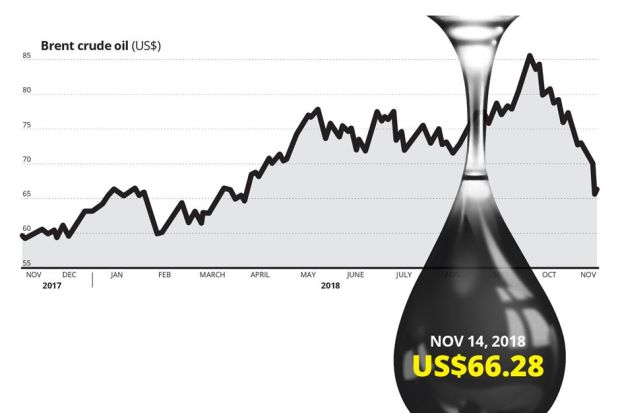Oil, commodities price dampener for Malaysia
PETALING JAYA: Tumbling crude oil prices have stoked concerns over the government’s ability to meet its budget deficit target in 2019.
The market has also turned nervy, considering the potential impact on oil and gas (O&G) companies as well as the government’s coffers.
The Brent crude oil futures closed at US$65.46 per barrel as at 5pm yesterday. The international oil price benchmark is now at a seven-month low, having fallen by nearly 24% since its year-to-date peak of US$85.83 per barrel in October.
Meanwhile, the US West Texas Intermediate (WTI) crude oil closed at US$55.47 per barrel. The price of the crude oil grade, which has been declining for 12 consecutive days, is currently at the lowest in one year.
Globally, oil prices have been slumping on the back of weakening demand and increasing supply. The weak prices are compounded by US president Donald Trump’s policy of wanting lower oil prices to reduce the inflationary effect on the US economy.
On the domestic front, tumbling crude oil prices mean that the government would see increasing challenges to finance Budget 2019.
According to the Fiscal Outlook and Federal Government Revenue Estimates, the average oil price for 2019 and 2020 is between US$60 and US$70.
Economists have a mixed view on the oil price trend, going forward.
AmBank Research chief economist Anthony Dass expects Brent oil to average at around the US$65 to US$69 levels in 2019.
Another economist from a local investment bank has made a more conservative forecast of US$60 per barrel, describing the projection as “playing safe”.
However, Singapore-based Oanda Corp head of trading for Asia-Pacific Stephen Innes is more positive on oil price prospects, with a forecast of US$70 to US$75 per barrel in 2019.
Not only that, earlier in October, S&P Global Ratings revised its Brent crude forecast for 2019 to US$70 per barrel, up from its initial estimate of US$65.
However, the rating agency pointed out that supply concerns remain elevated moving into next year.
Innes cautioned that a continued fall in crude oil prices would weigh on Malaysia’s budgetary and fiscal concerns. He also said that lower oil prices would be a negative driver for the already-weakening ringgit.
“Combined with policy divergence between Bank Negara and the Federal Reserve, I suspect the ringgit could trade at RM4.25 per greenback by end-2019,” said Innes in an e-mail interview.
Dass said that concerns on the country’s fiscal deficit would creep up, should the oil price continue to slide for a prolonged period.
“For now, we think the slide in the oil price should potentially stabilise. For 2018, the 3.7% deficit target should be within reach.
“However, the focus would be on the 2019 deficit of 3.4% if the price goes below US$60 per barrel,” he said.
Apart from the price forecast of oil going forward, another issue that has cropped up is the estimate which was used to prepare Budget 2019.
The declining oil price was fodder for former Prime Minister Datuk Seri Najib Tun Razak’s speech at Parliament yesterday, where he criticised the budget for assuming a high price for crude.
“It has not even been 10 days since Budget 2019 was tabled and the oil price assumptions have already become irrelevant.
“This is a serious matter. What if it drops further, until US$55?” asked Najib.
However, an economist told StarBiz that the government’s move to use an estimate of US$70 per barrel is well understood, as at the time some analysts were even forecasting oil at US$100.
“The Finance Ministry is not specialised in forecasting oil prices, and the number is usually based on Petroliam Nasional Bhd’s (Petronas) feedback and the forecasts by the market. Previously, Petronas mentioned that it expects the oil price to be at US$66 next year,” he said.Morgan Stanley Research said that the near-term implications of the lower oil prices were “negative” on Malaysia, especially with the oil price set at US$70 per barrel in Budget 2019.
“With equity markets taking an increased focus on the fiscal position given elevated public debt levels at 80% (including contingencies), upside risks to the deficit would likely be reflected in lower valuations,” it said in a note yesterday.
The impact of the falling oil prices was felt by O&G stocks.
Shares in Petronas Gas Bhd  (PGas), Petronas Chemicals Group Bhd
(PGas), Petronas Chemicals Group Bhd  (PetChem) and Dialog Group Bhd
(PetChem) and Dialog Group Bhd  fell yesterday following the slump in crude oil prices and also the weaker broader market. PGas fell 0.43% to RM18.66, while PetChem slid 1.47% to RM9.40. Dialog lost 3.98% to RM3.14. However, retailer Petronas Dagangan Bhd
fell yesterday following the slump in crude oil prices and also the weaker broader market. PGas fell 0.43% to RM18.66, while PetChem slid 1.47% to RM9.40. Dialog lost 3.98% to RM3.14. However, retailer Petronas Dagangan Bhd  rose 0.75% to RM26.80.
rose 0.75% to RM26.80.
According to Kenanga Research O&G analyst Sean Lim, the current oil price trend signifies worrying prospects for the companies in the O&G segment.
He said the adverse impact would be more pronounced among the players in the exploration and production business.
“I expect the Brent oil price to be above US$70 per barrel next year. However, if the oil price continues to decline, upstream players such as Reach Energy Bhd  , Hibiscus Petroleum Bhd
, Hibiscus Petroleum Bhd and Sapura Energy Bhd
and Sapura Energy Bhd  may see their operations and earnings being affected.
may see their operations and earnings being affected.
“As for the downstream segment, there would also be some impact on the companies. Overall, I am neutral on the outlook of the O&G sector in 2019,” he said.
Lim also cautioned that Petronas may curtail its activities due to the low oil price environment and this would affect the operations of the other players, especially the O&G services companies.
Source: https://www.thestar.com.my/business/business-news/2018/11/15/oil-price-dampener/#ge3RWzbeV5WiiM7S.99


 English
English




